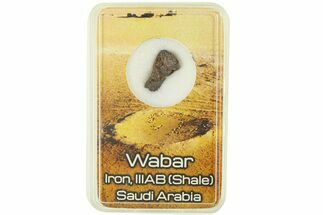.73" Whitecourt Iron Meteorite (8.66 g) - Alberta, Canada
This is a .73" wide (8.66 gram) fragment of the Whitecourt iron meteorite which was found in Alberta, Canada.
About The Whitecourt Meteorite
The Whitecourt Meteorite is a iron meteorite discovered in Alberta, Canada, near the small town of Whitecourt. It is estimated to have impacted Earth around 1,100 years ago, creating one of Canada's youngest known meteorite craters. The impact site, known as the Whitecourt Crater, is approximately 36 meters (118 feet) in diameter and well-preserved, offering valuable insights into recent meteorite impacts.
The meteorite itself is composed primarily of nickel-iron alloy and exhibits a characteristic metallic luster. It is classified as a coarse octahedrite, showcasing distinctive Widmanstätten patterns when cut and etched. Small fragments and shrapnel from the meteorite have been found around the crater, with many pieces displaying regmaglypts, or thumbprint-like depressions, caused by atmospheric ablation during its fiery descent.
The Whitecourt Meteorite is a iron meteorite discovered in Alberta, Canada, near the small town of Whitecourt. It is estimated to have impacted Earth around 1,100 years ago, creating one of Canada's youngest known meteorite craters. The impact site, known as the Whitecourt Crater, is approximately 36 meters (118 feet) in diameter and well-preserved, offering valuable insights into recent meteorite impacts.
The meteorite itself is composed primarily of nickel-iron alloy and exhibits a characteristic metallic luster. It is classified as a coarse octahedrite, showcasing distinctive Widmanstätten patterns when cut and etched. Small fragments and shrapnel from the meteorite have been found around the crater, with many pieces displaying regmaglypts, or thumbprint-like depressions, caused by atmospheric ablation during its fiery descent.
About Iron Meteorites
Iron type meteorites are composed primarily of iron and nickel, and are the remnants of differential cores torn apart at the beginning of the solar system. These metallic meteorites are often the easiest to identify after millions of years post-impact because they are quite different from terrestrial material, especially when it comes to their mass-to-surface area ratio. They are exceptionally heavy for their size since iron is a high-density metal: this is also why the Earth's core is nickel-iron. As planets form, the densest metals form gravitational centers, bringing more and more material into their gravitational pull. In the solar system's rocky planets, these dense materials are most often nickel and iron.
Most iron meteorites have distinctive, geometric patterns called Widmanstätten patterns, which become visible when the meteorite is cut and acid etched. These patterns are criss-crossing bands of the iron-nickel alloys kamacite and taenite that slowly crystalized as the core of the meteorites' parent bodies slowly cooled. Such large alloy crystallizations for mover millions of years and do not occur naturally on Earth, further proving that iron meteorites come from extraterrestrial bodies.
Iron type meteorites are composed primarily of iron and nickel, and are the remnants of differential cores torn apart at the beginning of the solar system. These metallic meteorites are often the easiest to identify after millions of years post-impact because they are quite different from terrestrial material, especially when it comes to their mass-to-surface area ratio. They are exceptionally heavy for their size since iron is a high-density metal: this is also why the Earth's core is nickel-iron. As planets form, the densest metals form gravitational centers, bringing more and more material into their gravitational pull. In the solar system's rocky planets, these dense materials are most often nickel and iron.
Most iron meteorites have distinctive, geometric patterns called Widmanstätten patterns, which become visible when the meteorite is cut and acid etched. These patterns are criss-crossing bands of the iron-nickel alloys kamacite and taenite that slowly crystalized as the core of the meteorites' parent bodies slowly cooled. Such large alloy crystallizations for mover millions of years and do not occur naturally on Earth, further proving that iron meteorites come from extraterrestrial bodies.
$95
TYPE
Iron, medium octahedrite (IIIAB)
AGE
LOCATION
Whitecourt, Alberta, Canada
SIZE
.73 x .50 x .50", Weight: 8.66 grams
CATEGORY
ITEM
#312851
 Reviews
Reviews









